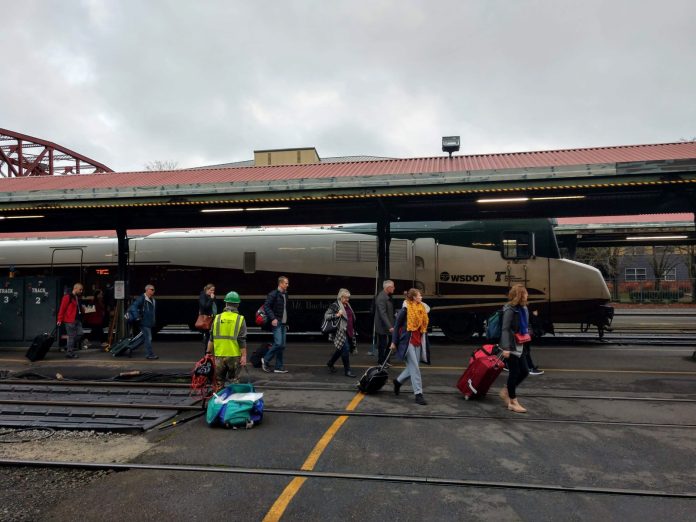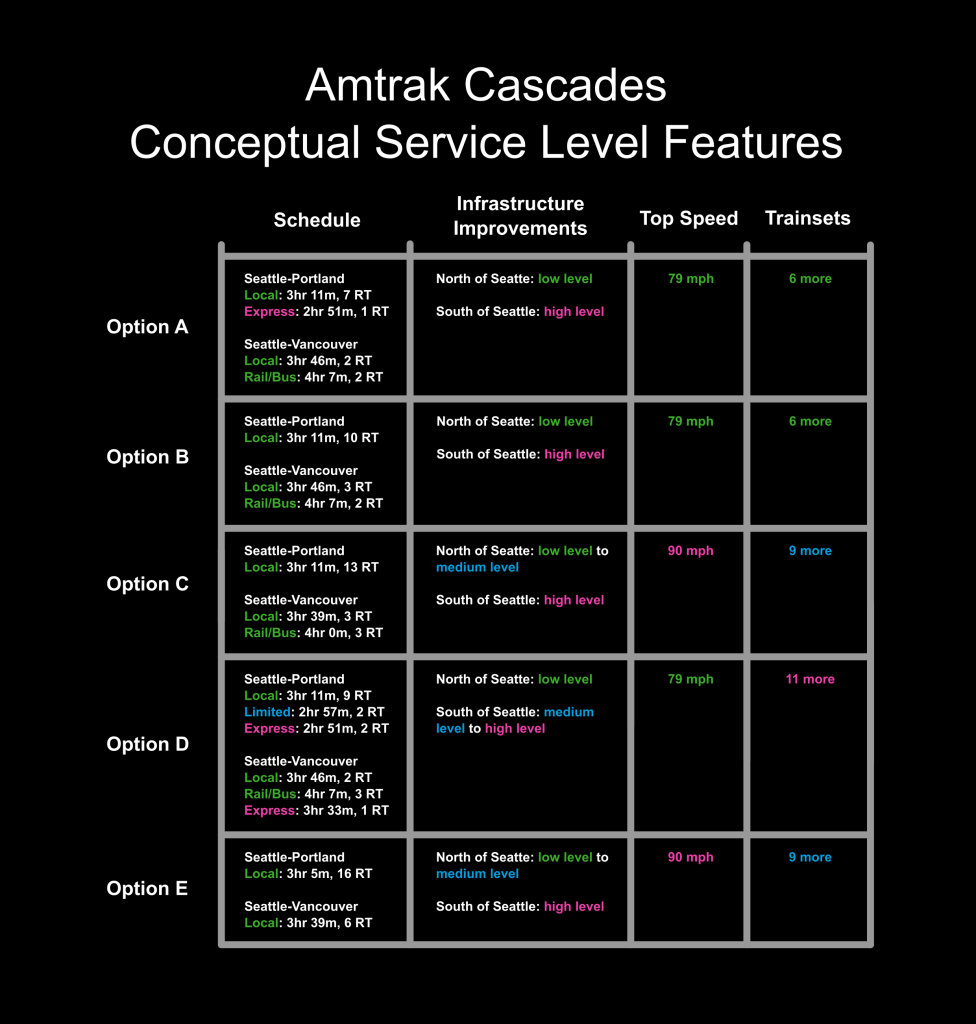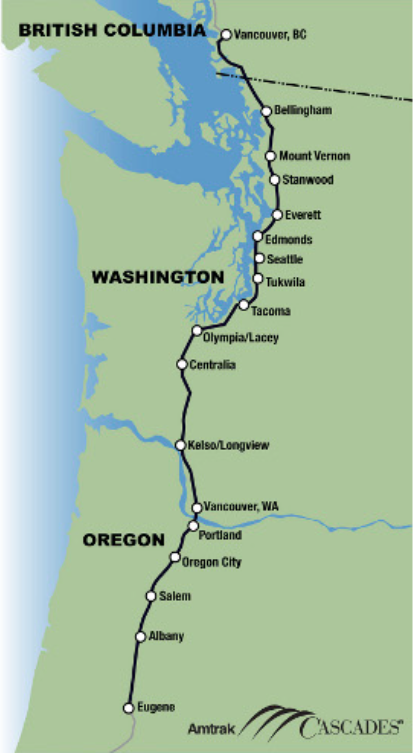
WSDOT is accepting public comment until April 18 and advocates need to weigh in.
The Washington State Department of Transportation (WSDOT) has opened a public comment period until April 18 on its proposals for an upgrade to Amtrak Cascades service, and now is the time for transportation advocates to weigh in. Do people want faster, more frequent, and reliable passenger train service in Western Washington, in the near future? Of course we do. Unfortunately, WSDOT’s plan doesn’t get us there, so urge them to deliver faster service as soon as possible.
Amtrak Cascades is the passenger rail service between Vancouver, B.C., Seattle, and Portland – with 11 additional stops along the route and three more south of Portland. If it were fast, frequent, and reliable, Amtrak Cascades would be a viable alternative that seriously competes with driving and flying. Besides, not everyone drives: according to Disability Rights Washington, 25% of Washingtonians don’t drive. And people who live in places far from airports can’t easily fly. For mobility equity and energy efficiency, we need more trains.
What WSDOT is accepting public comments on is called a “Preliminary Service Development Plan” for Amtrak Cascades. Don’t be put off by the bureaucratic-speak of this title. The plan will determine our rail options in Western Washington for the next 20 years, so it’s crucial that readers understand how WSDOT’s proposals water down the goals established in 2006 and 2019, when the state affirmed 2.5 hour trip times from Seattle to Portland, and 2 hour and 45 minute trip times from Seattle to Vancouver, B.C.
Basically, WSDOT offers five different scenarios, A through E. They range from eight to 16 round trips per day between Seattle and Portland and four to six round trips per day between Seattle and Vancouver, B.C. How long would these trips be? The scenarios with the fastest trip times stopping at all the stations would be 3 hours 5 minutes between Seattle and Portland and 3 hours 39 minutes between Seattle and Vancouver, B.C. Maximum speed is 79 mph in some scenarios and 90 mph in others. A few scenarios achieve slightly faster times, but only by skipping stops. Why should smaller towns be passed by when there are other options to achieve faster service?

What is wrong with this picture? In a time of unprecedented ballooning of highway construction costs, unmet mobility equity needs, and the climate crisis, WSDOT’s proposals are mediocre and fall far short.
First, we need trip times that are comfortably competitive with car travel and short-distance flights. The Amtrak Cascades Service Development Plan goals are not fast enough. Why has WSDOT set aside its own previous goals for 2.5 hour trips between Seattle and Portland, and 2.7 hour trips Seattle-Vancouver, B.C.? These faster, more attractive trip times were established in the 2006 Long Range Plan for the Amtrak Cascades, paid for with tens of millions of taxpayer dollars when WSDOT was instructed to develop a plan for passenger rail that would get as many vehicles off the roads as possible.
WSDOT’s service plan inexplicably dismisses the 2006 Long Range Plan for Amtrak Cascades as outdated, but its faster trip times are repeated in Washington’s 2019 State Rail Plan. Why should we accept less ambitious goals in 2024 than we did in 2006 or 2019?
Second, the options WSDOT is proposing maintain 90 mph as a maximum speed, and that is not fast enough. We know 110 mph is possible, because sections of 110 mph were agreed to by WSDOT and BNSF in a Master Agreement that expired less than a year ago, in June 2023. It’s simply not credible that WSDOT can’t work with BNSF to reinstate a 110 mph maximum speed — for example, between Nisqually and Centralia, on a third passenger-only track. We therefore reject WSDOT’s unambitious proposal of a 90 mph maximum.
On the face of it, WSDOT’s proposal for 16 daily round trips in option E is a great prospect! The trouble is that WSDOT’s plan leaves out the kind of infrastructure projects that would support 16 daily round trips. What’s the point of this kind of frequency if the trains continue to get jammed up in the bottleneck between Dupont and Centralia where the curves require trains to slow down to 30 mph and there is not enough track to accommodate even the current number of freight and passenger trains? We need significant infrastructure projects, and the plan should include them rather than ignore them.
And where are the guarantees for reliability? Currently, on-time performance of Amtrak Cascades is at about 50% — not a record that inspires confidence and far off the goal of 88% that WSDOT previously set. WSDOT’s options seem to be based on a belief that reliability can be improved with small projects and better maintenance. According to rail experts in Climate Rail Alliance and Solutionary Rail, however, major infrastructure projects are essential not only to shorten trip times but also to guarantee reliability.
Last but not least, with the climate crisis and accelerating population growth already upon us, a 20-year timeframe for Amtrak Cascades is simply not acceptable. The Intergovernmental Panel on Climate Change has repeatedly stated we need to slash both our carbon emissions and our energy use overall by 2030, just six years from now. Despite Washington state’s own emissions goals, we are not on a path to achieve reductions in energy use or emissions on the scale that is necessary. Trains are much more energy efficient than electric cars and trucks and can be electrified with minimal reliance on resource-intensive batteries. We need fast, frequent, reliable trains in 10 years or less, not 20.
We ask transportation advocates to weigh in on WSDOT’s Preliminary Service Development Plan for the Amtrak Cascades, by April 18. Action pages are set up on the Solutionary Rail website, the Climate Rail Alliance website, and by 350 Seattle. Comments can be submitted directly to CascadesSDP@wsdot.wa.gov. Thank you in advance for demanding the rail service we must have by 2030, for the sake of mobility and the planet.




